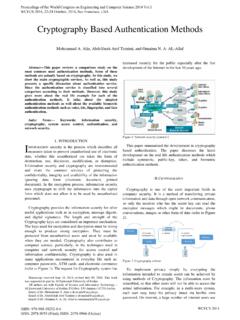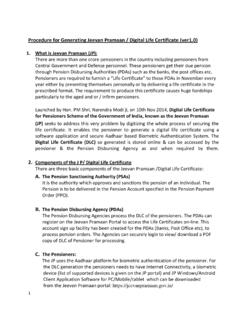Transcription of UIDAI
1 UIDAI Unique Identification Authority of India Govt. of India (GoI), 3rd Floor, Tower II, Jeevan Bharati Building, Connaught Circus, New Delhi 110001 AADHAAR authentication API SPECIFICATION - VERSION (REVISION 1) FEBRUARY 2017 Version (Rev 1) Aadhaar authentication API UIDAI , 2011-2017 Page 2 of 33 Table of Contents 1. INTRODUCTION .. 3 TARGET AUDIENCE AND PRE-REQUISITES .. 3 TERMINOLOGY .. 4 LEGAL FRAMEWORK .. 4 OBJECTIVE OF THIS DOCUMENT .. 4 2. UNDERSTANDING AADHAAR authentication .. 5 AADHAAR NUMBER .. 5 AADHAAR authentication AT A GLANCE .. 5 AADHAAR authentication USAGE .. 6 CONCLUSION .. 6 3. AADHAAR authentication API .. 7 authentication FLOW .. 7 API PROTOCOL .. 8 Element Details .. 9 authentication API: INPUT DATA FORMAT .. 10 Element Details .. 11 authentication API: RESPONSE DATA 23 Element Details.
2 23 4. API AND DATA SECURITY .. 31 authentication DATA SECURITY .. 31 USING BINARY FORMAT FOR PID BLOCK .. 32 authentication AUDITS .. 32 5. APPENDIX .. 33 CHANGES IN VERSION FROM VERSION .. 33 Version (Rev 1) Aadhaar authentication API UIDAI , 2011-2017 Page 3 of 33 1. Introduction The Unique Identification Authority of India ( UIDAI ) has been created, with the mandate of providing a Unique Identity (Aadhaar) to all Indian residents. The UIDAI provides online authentication to verify the identity claim of the Aadhaar holder. Aadhaar authentication means the process wherein Aadhaar Number, along with other attributes, including biometrics, are submitted to the Central Identities Data Repository (CIDR) for its verification on the basis of information or data or documents available with it. UIDAI provides an online service to support this process. Aadhaar authentication service only responds with a yes/no and no personal identity information is returned as part of the response.
3 Target Audience and Pre-Requisites This is a technical document and is targeted at software professionals working in technology domain and interested in incorporating Aadhaar authentication into their applications. Before reading this document, readers are highly encouraged to read the following documents to understand the overall system: 1. UIDAI Strategy Overview - 2. The Demographic Data Standards and verification procedure Committee Report - 3. The Biometrics Standards Committee Report - Readers must also read the following related documents for complete understanding. 1. Aadhaar Best Finger Detection API - 2. Aadhaar OTP Request API - 3. Aadhaar Registered Devices Specification - Version (Rev 1) Aadhaar authentication API UIDAI , 2011-2017 Page 4 of 33 Terminology authentication User Agency (AUA) and Sub-AUA: An organization or an entity using Aadhaar authentication as part of its applications to provide services to Aadhaar holders.
4 Examples include Government Departments, Banks, and other public or private organizations. All AUAs ( authentication User Agencies) must be registered within Aadhaar authentication server to perform secure authentication . Sub-AUA is an an entity having a business relationship with AUA offering specific services in a particular domain. authentication Service Agency (ASA): An organization or an entity providing connectivity using private secure network to UIDAI s data centres for transmitting authentication requests from various AUAs. authentication Factors: Aadhaar authentication supports authentication using multiple factors. These factors include demographic data, biometric data, PIN, OTP, possession of mobile, or combinations thereof. Adding multiple factors increases the strength of authentication . Applications using Aadhaar authentication need to choose appropriate authentication factors based on risk level of the transaction.
5 AUAs can add their own factors to strengthen authentication . Legal Framework The Aadhaar (Targeted Delivery of Financial and Other Subsidies, Benefits and Services) Act 20161 was published in gazette notification on March 26, 2016. The Act is to provide for, as a good governance, efficient, transparent, and targeted delivery of subsidies, benefits and services to Aadhaar number holders. A gazette notification was issued by Central Government on 12th July 2016 to establish UIDAI as an Authority2 and operationalize certain provisions of Aadhaar Act 2016. authentication regulations are also published under this Act. These documents specify legal framework for authentication usage, AUA/ASA engagements, audits, and other details. Detailed partner documents are also published. These documents are available at Objective of this document This document provides Aadhaar authentication API (Application Programming Interface) specification.
6 It contains details including API data format, protocol, and security specifications. For latest documents related to Aadhaar authentication , partner guidelines, other APIs, and related documents, see Version (Rev 1) Aadhaar authentication API UIDAI , 2011-2017 Page 5 of 33 2. Understanding Aadhaar authentication This chapter describes Aadhaar authentication , some of the envisioned usage scenarios, and working details. Technical details follow in subsequent chapters. Aadhaar Number The Unique Identification (Aadhaar) Number gives individuals the means to clearly establish their identity to public and private agencies across the country. Three key characteristics of Aadhaar Number are: 1. Permanency (Aadhaar number remains same during lifetime of the person) 2. Uniqueness (one Aadhaar holder has one ID and no two Aadhaar holders have same ID) 3. Global (same identifier can be used across applications and domains) Aadhaar Number is provided during the initiation process called enrolment where his/her demographic and biometric information are collected and uniqueness of the provided data is established through a process called de-duplication.
7 Post de-duplication, an Aadhaar Number is issued and a letter is sent to Aadhaar holder informing the details. Aadhaar authentication at a Glance Aadhaar authentication is the process wherein Aadhaar Number, along with other attributes, including biometrics, are submitted online to the CIDR for its verification on the basis of information or data or documents available with it. Aadhaar authentication provides several ways in which an Aadhaar holder can authenticate themselves using the system. At a high level, authentication can be using Demographics data and/or biometric (FP/Iris/Face) data, and/or OTP. Face authentication is currently not supported. During the authentication transaction, the Aadhaar holder s record is first selected using the Aadhaar Number and then the demographic/ biometric inputs are matched against the stored data within CIDR which was provided by the Aadhaar holder during enrolment/update process.
8 In all forms of authentication the Aadhaar Number needs to be submitted so that authentication is reduced to a 1:1 match. In addition, Aadhaar authentication service only responds with a yes/no and no Personal Identity Information (PII) is returned as part of the response. Version (Rev 1) Aadhaar authentication API UIDAI , 2011-2017 Page 6 of 33 Aadhaar authentication Usage Aadhaar authentication enables agencies to verify identity of Aadhaar holders using an online and electronic means where the agency collects required information from the Aadhaar holder along with Aadhaar Number and passes the same to UIDAI systems for verification. Aadhaar authentication service provides services to instantly verify the identity of the Aadhaar holder against the available data in CIDR. Based on the needs of the service, different identifiers could be used along with Aadhaar Number.
9 These identifiers could be combination of biometrics (such as fingerprints, iris impressions) and/or demographic information (such as Name, Date of birth, Address) and/or a secret PIN or OTP (One Time Pin). Aadhaar Number along with certain demographic information such as name, date of birth, etc. helps to provides for simple authentication needs. For example, when MGNREGA beneficiary is enrolled and given a job card, Aadhaar holder could be biometrically authenticated against Aadhaar system to verify his/her Aadhaar number along with name, address. For further details on usage of Aadhaar in various service delivery scenarios, refer to Aadhaar Enabled Service Delivery White Paper published on UIDAI website - Conclusion Aadhaar authentication provides a convenient mechanism for all Aadhaar holders to establish their identity.
10 It provides a platform for identity authentication and can be used to deliver services effectively to Aadhaar holders across the country. Rest of the document is technical in nature and is intended for software professionals working with applications wanting to enable their applications to support Aadhaar authentication . Version (Rev 1) Aadhaar authentication API UIDAI , 2011-2017 Page 7 of 33 3. Aadhaar authentication API This chapter describes the API in detail including the authentication flow, communication protocol, and data formats. authentication Flow Following diagram explains various authentication scenarios and data flow. Scenario 1 in the diagram is a typical authentication flow and is a case of an operator assisted transaction at a PoS terminal: a) Aadhaar holder provides Aadhaar Number or AUA/Sub-AUA specific identifier, necessary demographic and biometric details to terminal devices belonging to the AUA/Sub-AUA (or merchant/operator appointed by AUA/Sub-AUA) to obtain a service offered by the AUA/Sub-AUA.




